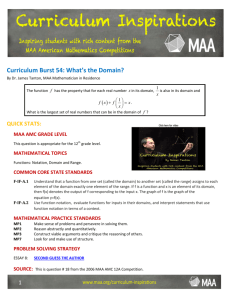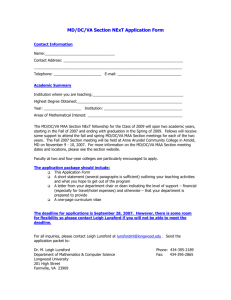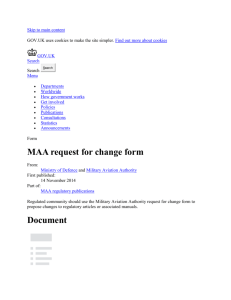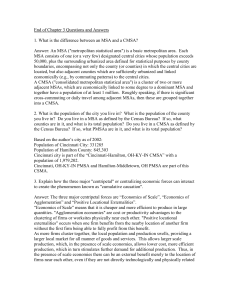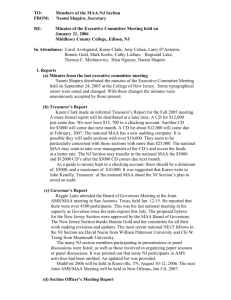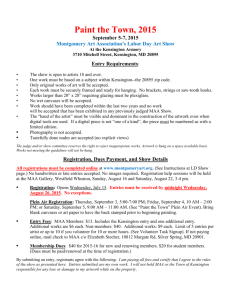Lab 2 Lecture
advertisement
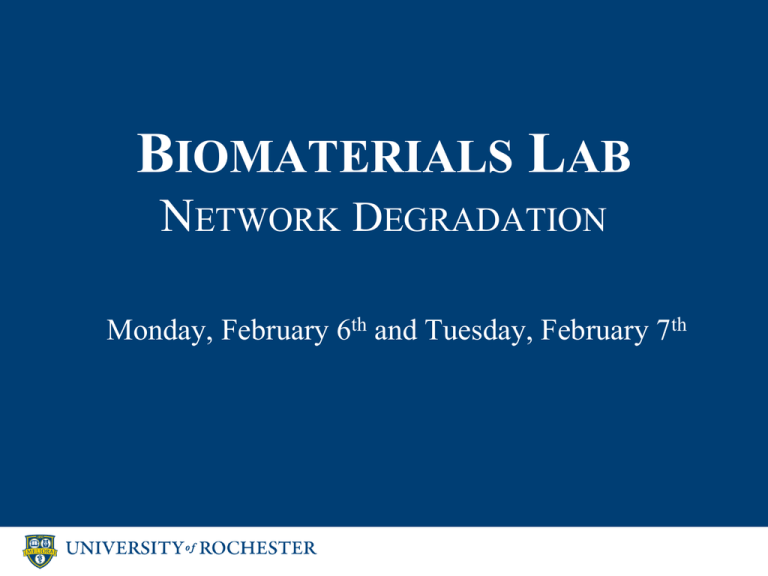
BIOMATERIALS LAB NETWORK DEGRADATION Monday, February 6th and Tuesday, February 7th PRE-LAB Sign-in Quiz (Metters. 2000) Rectangular Approximation "Approximating the Area Under a Curve for AP Calculus | Education.com." Education.com | An Education & Child Development Site for Parents | Parenting & Educational Resource. Web. 06 Feb. 2012. <http://www.education.com/study-help/article/rectangularapproximations/>. Procedural Notes Teamwork Take turns pipetting, massing, ect. but make sure you remember what has been added to the solution Pipetting Check the volume, change by twisting dial When filling, go to first stop When ejecting precursors, go to second stop When ejecting into syringe mold, go to first stop (to avoid bubbles) LINEAR MOLECULES PEG-PLA-MA MSA MAA (CH2)4 METHACRYLATE POLYMERIZATION Step-growth Polymerization 1 “Arm” …… PEG PLA MA Unlike last lab, each double bond can hook up with TWO other molecules. (Lin, C.C., Pharmaceutical Research. 26(3): 631-643. 2009) SECTION 1 PEG-PLA-MA Network Synthesis Can surmise from Metters.2000 this will be bulk degrading Monitor change in network over time… Size (diameter / height) Weight Young’s Modulus Stereo-microscopy Imaging Polyanhydrides. Wikipedia. 2011 PEG NETWORK SYNTHESIS 1. 10wt% PEG-PLA-MA in PBS 2. 10% photo-initiator by volume (LAP) 3. 40μL placed in 1mL syringe (tip cut off) to create cylindrical hydrogel sample geometry 4. exposed to UV-lamp for 10min 5. Remove and place in PBS 6. 3 PEG samples SECTION 2 MSA/MAA Network Synthesis Glassy polymer Monitor change in network over time… Size (diameter / height) Weight Young’s Modulus Stereo-microscopy Imaging Polyanhydrides. Wikipedia. 2011 (CH2)4 MSA/MAA NETWORK SYNTHESIS Unlike PEG-PLA-MA, the MSA/MAA is a bulk reaction that is not polymerized in a liquid phase. 1. 2. 3. 4. 5. ≈0.25g of MSA/MAA 0.1wt% DMAP photo-initiator added to PA-MA Fill mold “sandwich” (glass slide / Teflon / glass slide) exposed to UV-lamp for 10min Remove and place in PBS 6. 1 MSA/MAA sample TESTING Young’s modulus in Materials Testing Lab – 5N load cell Mass – after patting networks dry Size – use calipers for height and diameter. Don’t squish hydrogel All three will be assembled and posted on blackboard. Stereo-microscopy Imaging – collect images with digital camera Each group is responsible for collecting their own images All performed on D0, D1, D3, D8, D10 Big Picture Control of mechanical properties & degradation behavior allows tuning to your application Ex: Control degradation rate Control drug release rate Bulk Typically hydrophilic Biologically inert Large number of available chemistries Surface Typically hydrophobic Protein adsorption, cell interaction Constant turnover at surface difficult to integrate with tissue Applications Prevent postsurgical adhesion formation In vivo drug and protein delivery Temporary scaffold for tissue repair Degradable sutures SECTION 3 Degradation time-course Look at how networks degrade over time 1 team member per data collection day DAY Monday’s Lab Tuesday’s Lab 0 Monday, February 6th (in lab) Tuesday, February 7th (in lab) 1 Tuesday, February 7th Wednesday, February 8th 3 Thursday, February 9th Friday, February 10th 8 Tuesday, February 14nd Wednesday, February 15th 10 Thursday, February 16th Friday, February 17th

